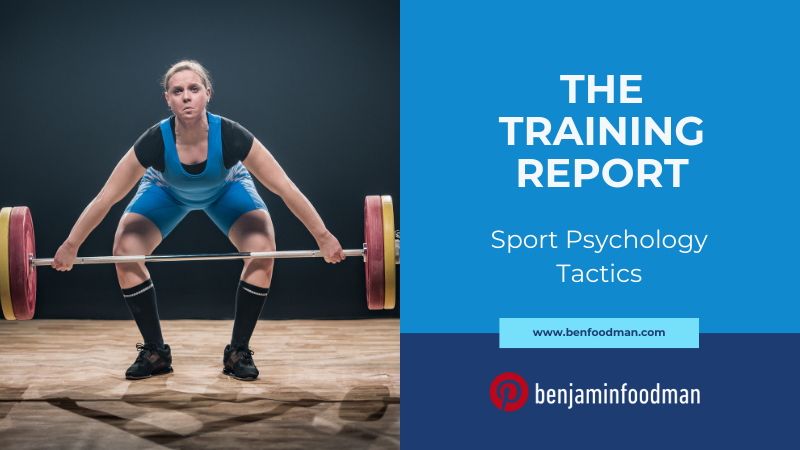Sport Psychology Tactics - EMDR Therapy For Athlete Mental Skills Training
About the Author
Ben Foodman is a licensed psychotherapist & performance specialist. He owns his private practice located in Charlotte North Carolina where he specializes in working with athletes to help them overcome mental blocks (the yips), PTSD, ADD / ADHD and achieve flow states through the techniques of Brainspotting & Neurofeedback. If you are interested in services, use the link here! Enjoy the article below!
Introduction: Can EMDR Therapy Help Improve Athletic Achievements?
Whether you are competing at the high school level, division I & II college level, or world championship events, the stress associated with sports can be brutal. All athlete populations have to train on a regular basis in order to maintain their training effect and also generate new levels of performance so they can achieve new PRs (personal records). This can be a mentally grueling process in terms of the pressure to create new PR, please coaches and families, and tune out the ‘chatter’ from opposing teams and athletes. Also factor in how the physical demands of these sports can take a severe toll on the body, and you have athletes that are constantly sore, ‘managing’ injuries, and constantly stressed about whether or not they are achieving new performance standards.
Because this is a predictable feature of sports performance, athletes need to regularly engage in the most cutting-edge mental training strategies available in order to stay ahead of psychological setbacks and achieve peak performance. While my main focus as a clinician is Brainspotting, one of the most effective interventions that athletes can select from if Brainspotting is not available to them is EMDR (Eye Movement Desensitization & Reprocessing). For this issue of the Training Report I want to discuss in part I. what EMDR is, in part II. I will review how EMDR relates to athlete performance outcomes, and in part III. I will discuss how both Brainspotting and/or EMDR can help athletes achieve peak performance outcomes. Let’s begin by reviewing what EMDR is.
Part I. What Is EMDR Therapy?
While very uncommon, there is a growing number of sport psychologists and athlete therapists that are beginning to use Eye Movement Desensitization Reprocessing (EMDR) therapy when working with athletes. In the book Emotional Healing At Warp Speed, by Dr. David Grand, he provides detailed insight into what EMDR is and why it is one of the most effective psychotherapy techniques on the market outside of Brainspotting. The author states the following: EMDR is essentially a body-oriented treatment. The purpose of the step-by-step protocol, proceeding from target image to cognition to emotions, is to arrive at the container of the body. Once the patient has reprocessed an experience, the final step validating the completion of the healing is to scan the body. Is there any tension left? Any discomfort or uneasiness? A newborn baby cannot differentiates between body sensation and emotion. Hunger, being soiled, fear, frustration, and contentment are all felt in the body and are differentiated only as comfort and discomfort. The reptilian brain and the body are acting as one. Discomfort is discomfort, whether it’s emotional or physical. The same thing applies to comfort.
The author continues: EMDR itself is centrally located among the various forms of psychotherapy. If you imagine a wheel with all other psychotherapies as its spokes, EMDR can be found at its core. Thought, sensory memory, emotion, and body experience are all components of psychological life and cannot be separated. if you ignore the body in trying to understand emotion, you lose the resonance of the feeling. How we demonstrate our emotions through posture, facial expression, and ‘body language’ is as crucial to communication as spoken words. No social contact, no intimate relationship, no business exchange exists without body language. For it is here that the unconscious, unspoken, underlying feelings are expressed. ‘I love you’ the young woman says to her boyfriend, shying away from his touch. ‘I won’t hurt you’ the bully promises, aggressively in his victim’s face. ‘That’s my best offer’ the salesman says, suddenly sweating, pupils dilating. In each case, it is the language of the body, not the words surrounding it, that speaks the truth. EMDR presents constant opportunities to access meaning through the body and in some instances to treat emotions that are preverbal. If, at three months, a baby falls into a pool and nearly drowns, that trauma is recalled in the sensation of suffocation along with the terror that accompanied it. years later it might show up as a breathing difficulty, perhaps asthma or panic attacks. Experiences that are reminiscent of the original trauma will trigger an adrenaline release by the brain that is felt primarily in the body. From brain to body to brain is a loop that has no true beginning or end. Now that we have an introductory explanation for what EMDR is, we need to explore how it works for athletes?
Part II. How Does EMDR Therapy Relate to Athletic Achievements?
A common issue that many athletes deal with are mental blocks. These mental blocks are usually a result of trauma and can cause the Yips or PTSD-like symptoms. In the book This Is Your Brain On Sports by David Grand, the author goes into detail explaining what happens in the brain that causes PTSTD and the Yips. Per the author ‘In parallel fashion, the brain attempts to always move toward a state of psychological equilibrium. Over the course of our lives, we are exposed to a variety of life experiences, some positive, some neutral, and some negative. Through a natural assimilation process, the brain adaptively processes these experiences so they are constructively integrated. What is useful from the experience is learned and stored in the brain with the appropriate emotion and is available for future use. When an experience is successfully assimilated or digested it is stored in the brain with little attached intense emotion or physical sensation. When we recall such an incident, we don’t reexperience the old emotion or sensation with it. In this way we are informed by our past experiences and memories but not controlled by them and with sports our present athletic performances are not burdened by emotional or physical baggage from the past, only learned experience. By contrast, trauma or any strongly negatively charged experience isn’t adequately assimilated or processed. Instead, the upsetting incident remains stuck in the system in broken pieces’.
The author continues, ‘ The body instantly memorizes the physical experience of the trauma in exquisite detail, including the body sensations of the impact and pain, along with the associated sights, sounds, smells and tastes. The attached emotions and where they are felt in the body are frozen as well. The brain is overwhelmed and instead of getting digested, all of the information attached to the injury, including the negative thoughts is stored in the brain in exactly the same form it was initially experienced. Days, week, months or even years later when the athlete is in a situation reminiscent of the original trauma or experiences prolonged stress, the upsetting experience may be unconsciously activated, thus interfering with the performance of the moment. These components represent all of the sensory details from the earlier event that were frozen in the brain and body in their original disturbing state: the images, lighting, emotions, physical movements, sounds, or smells. The unique sensory details later returning to consciousness cause the performance disrupting symptoms so common in mental blocks.’
To further emphasize the point, in the book The Body Keeps The Score, Dr. Bessel Van Der Kolk goes even deeper explaining how the mechanisms of the brain respond to stress (high levels of stress frequently are experienced in these sports), which in turn create the symptoms of PTSD and the Yips: the emotional brain has first dibs on interpreting incoming information. Sensory information about the environment and body state received by the eyes, ears, touch, kinesthetic sense, etc. converges on the thalamus where it is processed and then passed on to the amygdala to interpret its emotional significance. This occurs with lightning speed. If a threat is detected, the amygdala sends messages to the hypothalamus to secrete stress hormones to defend against that threat. The neuroscientist Joseph LeDoux calls this the low road. The second neural pathway, the high road, runs from the thalamus via the hippocampus and anterior cingulate, to the prefrontal cortex, the rational brain, for a conscious and much more refined interpretation. This takes several microseconds longer. If the interpretation of threat by the amygdala is too intense, and/or the filtering system from the higher areas of the brain are too weak, as often happens in PTSD, people lose control over automatic emergency response, like prolonged startle or aggressive outbursts. Understanding all of this science is important because it connect WHY EMDR is a critical tool for mental training for athletes. Since traumatic experiences are almost an inevitable part of sports, athletes need to mentally train their body and minds with tools like EMDR, because EMDR is a trauma-informed intervention. With that being said let’s dive deeper into how this enhances peak mental performance.
Part III. Peak Performance, Brainspotting & EMDR
EMDR and Brainspotting are both mental skills training tools that help athletes overcome mental blocks and achieve peak performance outcomes. But why is this the case? Let’s start off by understanding WHY an intervention like Brainspotting can accomplish this (Brainspotting’s core roots are from EMDR). Brainspotting is a brain-based psychotherapy technique that utilizes the client’s field of vision to identify unresolved psychological issues. In Brainspotting we say ‘where you look affects how you feel’ and through this process clients have the ability to access the parts of their brain that traditional psychotherapy approaches such as cognitive behavioral therapy are unable to do. This results in clients being able to directly address the true ‘underlying’ issue (which we refer to as a Brain Spot) that has created conflict allowing individuals to move from needing to constantly cope, to not needing to cope at all. Brainspotting can be used to help anyone who is dealing with mental blocks, the Yips, the twisties, psychologically traumatic events, chronic pain issues from injuries, as well as individuals who are trying to access deeper levels of creativity or cultivating mental flow states. When we think about the potential issues that athletes deal with that are connected to the Yips (sport humiliations, sports-injuries, out of sport trauma such as car accidents, interpersonal relationship issues), it can be easy to see why this intervention pairs perfectly with this athlete population.
The goal of all psychotherapy interventions are to help clients move from dysregulation to regulation. For instance if you are a baseball player and you have been experiencing the Yips coming in the form of freezing before a pitch, this can be considered a state of dysregulation. Because almost half of the brain is dedicated to vision, we use the client’s field of vision combined with focused mindfulness to help engage the regions of the brain that are responsible for regulation and bypass the regions that are not! This physiological approach can help clients achieve their desired psychological outcomes. When athletes work with a sport psychologist who uses Brainspotting, they will first identify what the issue is that they would like to resolve. These issues can range from experiencing pre-performance nerves in sports, to having anxiety about speaking in front of a team. Clients discuss the issue in-depth and then the sport psychologist invites clients to have their eyes follow a pointer that the clinician will move in certain directions to identify the eye position that is relevant to the topic that the client is looking to resolve. Once the eye position is identified, the client will hold that eye position for either several minutes up to two hours potentially until the issue is resolved. Whether athletes like it or not, the mental blocks and trauma are an inevitable part of sports for many athletes. In the same way athletes need to condition themselves to deal with predictable features of sport performance (e.g. working with a strength coach to increase power), Brainspotting and EMDR are a form of mental training that will help athletes either avoid or work through trauma and mental blocks!
Note To Reader:
If you are an athlete reading this segment of the TRAINING REPORT, hopefully this content was helpful! I put the Training Report together because I felt like many of the discussions on issues such as the Yips/mental blocks, strength training & other subject matter on athlete performance concepts were really missing the mark on these ideas (e.g. how trauma is the direct cause of the Yips). If you are interested in learning more, make sure to subscribe below for when I put out new content on issues related to sport psychology & athlete performance! Also, if you are looking to work with a mental performance specialist, you are in the right place! USE THIS LINK to reach out to me to see if my services are the right fit for your goals!
ARE YOU ON THE LIST?
Make sure you’re signed up to Ben’s mailing list to receive news & updates on new strategies in sport psychology, upcoming workshops & products. Don’t wait, sign up now!




















































































